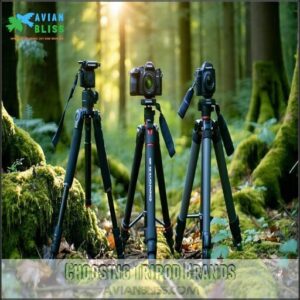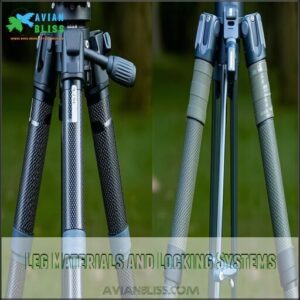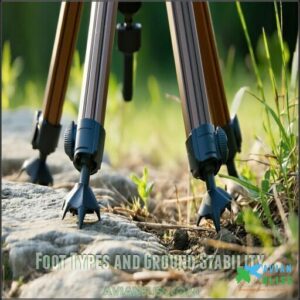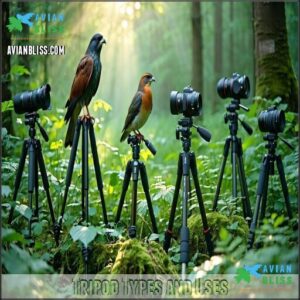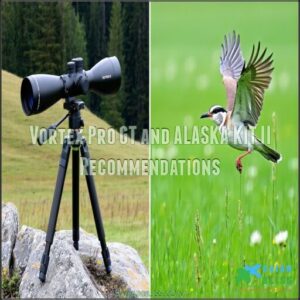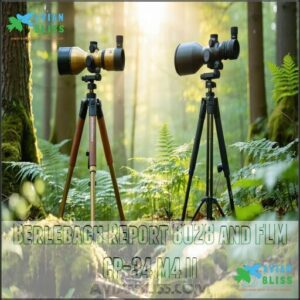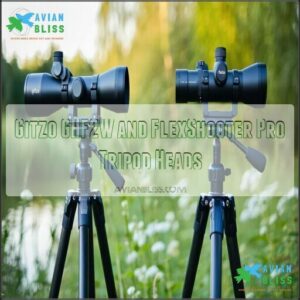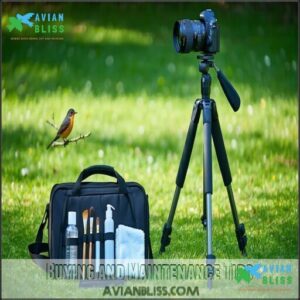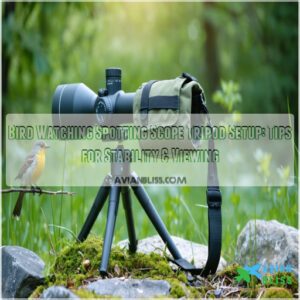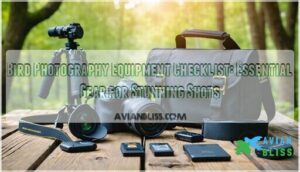This site is supported by our readers. We may earn a commission, at no cost to you, if you purchase through links.
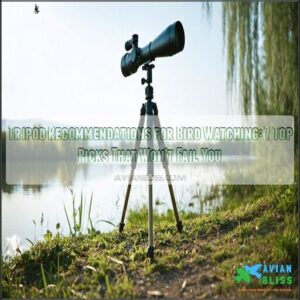 For bird watching, you’ll want a tripod that’s stable, lightweight, and easy to handle.
For bird watching, you’ll want a tripod that’s stable, lightweight, and easy to handle.
Look for carbon fiber models like the Vanguard VEO 3 or Kite Optics Ardea CF—they’re sturdy but won’t weigh you down. If budget’s a concern, aluminum options like the Vortex Pro GT are solid picks.
Pay attention to height and make sure it fits comfortably with your spotting scope, especially if you prefer angled viewing. A fluid head, like the Gitzo GHF2W, will make panning smooth and effortless.
Don’t overlook leg locks and foot grips for unpredictable terrain. The right tripod makes all the difference out there!
Table Of Contents
- Key Takeaways
- Choosing Tripod Brands
- Key Tripod Features
- Tripod Types and Uses
- Top Tripod Brands and Models
- Buying and Maintenance Tips
- Frequently Asked Questions (FAQs)
- What is the best tripod head for birds?
- Should you use a tripod for bird photography?
- What is the most appropriate optical device for bird watching?
- What are the best tripods for windy conditions?
- Are there any durable travel-size tripods for bird watchers?
- Which tripods work well in extreme temperatures?
- Do tripods differ between angled and straight scopes?
- How to prevent tripod legs from slipping on ice?
- Conclusion
Key Takeaways
- Look for carbon fiber tripods like Kite Optics Ardea CF for lightweight stability or aluminum options like Vortex Pro GT for durability on a budget.
- Prioritize tripods with fluid heads, like Gitzo GHF2W, for smooth panning and easy tracking of moving birds.
- Match tripod height and load capacity with your spotting scope’s design to ensure a steady setup and comfortable viewing setup.
- Choose models with adjustable leg locks and strong ground grips to handle uneven terrain and tough outdoor conditions.
Choosing Tripod Brands
You’ll need to focus on trusted names like Manfrotto, Gitzo, and Vortex when selecting your birding tripod, as these manufacturers have proven track records for quality construction and stability features that prevent scope shake during critical sightings.
The best tripod brands offer excellent customer support and warranties that protect your investment, ensuring you won’t miss that rare warbler because of equipment failure in the field.
Reputation and Customer Satisfaction
When selecting a tripod for bird watching, brand reputation and customer satisfaction should be your guiding stars.
Experienced birders often rely on:
- Customer reviews that highlight real-world performance in field conditions
- Warranty support that demonstrates the manufacturer’s confidence
- Long-term reliability ratings from birding communities and forums
Brands like Manfrotto, Gitzo, and Vortex consistently earn positive feedback for their responsive customer service and products that meet birders’ expectations, which is a key factor in customer satisfaction.
Quality of Materials and Construction
When examining tripod brands, pay close attention to material durability and build quality.
Tripods made with high-quality materials provide better vibration damping and weather resistance. Carbon fiber tripods offer superior stability but cost more than aluminum tripods.
Component engineering matters—a well-engineered tripod with excellent construction will outlast cheaper alternatives. The difference between a steady view and a shaky one often comes down to durable construction and thoughtful design.
Range of Options and Varieties
When shopping for a tripod, you’ll find an impressive range of options to match your birding needs.
Top brands offer material diversity from aluminum to carbon fiber, various head systems, different leg sections, and reliable locking mechanisms.
Some manufacturers provide specialized birding tripods alongside general-purpose models.
Look for brands that offer both budget-friendly starters and premium options with adjustable foot options for different terrains.
Compatibility With Spotting Scopes
Beyond brand variety, matching your tripod to your spotting scope is what matters most.
Tripod scope mounting requires appropriate load capacity for your scope weight. Most birding spotting scopes connect via standard mounting systems, but verify compatibility before purchase.
The balance point affects tripod scope stability substantially. Models like Manfrotto MT190X3 and Vortex Pro GT offer excellent vibration reduction and head stability, keeping your view steady when that rare warbler appears.
Value for Money and Price Comparison
While comparing tripod prices, focus on value for money rather than just the lowest cost.
Quality birding tripods typically start at $200, with Feisol offering excellent brand value.
The Vortex Pro GT provides good price vs. performance as an economical option, while the ALASKA KIT II delivers reliable stability.
When making tripod comparisons, consider feature prioritization and long-term cost over initial tripod price for the best recommendations.
Key Tripod Features
You’ll need to understand specific tripod features to make an informed choice for your bird watching adventures.
Height adjustment, stability mechanisms, head types, and material construction work together to determine how effective your tripod will be when tracking that elusive warbler or hawk in the field.
Height and Portability Considerations
While brand reputation matters, the ideal tripod height should match your user height and scope type.
When standing straight, your tripod should position the eyepiece at eye level without neck strain.
For travel needs, compact models offer portability but may sacrifice maximum height. Lightweight tripods under 4 pounds are ideal for bird watching trips.
Consider folded length if you’ll be packing your portable equipment in luggage or backpacks. For added stability, consider using a weight bag attached to the center hook.
Weight and Stability Factors
Now that you’ve considered the right height for your needs, let’s look at what keeps your scope steady.
When selecting a tripod, weight and stability go hand in hand, but they’re not always directly related.
- A tripod’s load capacity rating doesn’t guarantee stability – engineering quality often matters more
- Carbon fiber provides superior vibration damping but weighs less than aluminum
- Material impact is significant – a well-made 3-pound tripod can outperform a poorly designed 5-pound model
Head Types and Panning Mechanisms
The right tripod head makes all the difference in your birding experience.
Fluid heads provide smooth panning when tracking birds in flight, while ball heads offer quick positioning but less control.
Pan heads with tangent arms enhance stability during extended viewing sessions.
Video heads, especially micro-fluid pan models, deliver the fluid movement needed when sharing views with others or documenting sightings.
Choose based on your tracking needs, considering the type of head that best suits your birding experience.
Leg Materials and Locking Systems
The choice in tripod legs dramatically affects your birding experience.
Most tripods feature either aluminum legs (durable and cost-effective) or carbon fiber (lightweight with superior vibration dampening).
For locking systems, you’ll encounter twist locks that offer reliability over time, or flip levers for quick setup.
Three-section legs balance portability and stability, while four-section designs pack smaller, and it’s also important to look for insulated grips on aluminum models to prevent cold hands during winter birding, which can be a significant factor in your overall birding experience.
Foot Types and Ground Stability
While many birders debate the merits of different tripod feet, experts confirm that rubber feet provide sufficient grip for most environments.
Your tripod’s stability depends more on leg position than foot type.
Rubber feet work well on hard surfaces, while spikes might help on soft terrain.
Aftermarket feet are available if you need terrain-specific options, but for standard birding, the stock rubber feet on quality tripods perform adequately.
Tripod Types and Uses
You’ll find different tripod types to match your specific bird watching needs, from lightweight monopods for quick hikes to sturdy carbon fiber models for extended viewing sessions.
Each design serves a distinct purpose, with options ranging from all-in-one kits that include fluid heads for smooth tracking to specialized models featuring quick-release systems that let you set up in seconds when that rare warbler appears.
Monopods for Portability and Ease
When hiking through challenging terrain, a monopod offers the perfect balance between stability and portability for bird watching.
The Stilt Monopod features trigger mechanisms for quick height adjustment and a reliable quick-release system for your scope.
Unlike tripods, this one-leg support weighs substantially less, making it ideal when you need to travel light.
Many experienced birders keep both tripods and monopods in their bird watching gear collection.
Tripod Kits for Bird Watching
While monopods offer quick setup, tripod kits provide the complete package for serious bird watching.
These all-in-one solutions combine legs, head, and mounting systems designed specifically for birding scopes. Many retailers offer birding tripod kits for specialized needs.
- ALASKA KIT II features fluid head technology for smooth tracking of moving birds
- Vortex Pro GT offers the best value for budget-conscious birders
- The "Birder" Tripod Kit includes compatibility with most spotting scope brands
- Manfrotto MT190X3 kits provide excellent stability-to-weight ratios for portability needs
Carbon Fiber Vs Aluminum Tripods
When selecting tripods for bird watching, understanding material differences is essential.
Carbon fiber offers excellent vibration damping and lighter tripod weight but involves higher cost.
Aluminum guarantees better durability and handles temperature sensitivity well.
For ideal viewing, consider the tripod head options available for smooth panning.
Here’s a breakdown:
| Feature | Carbon Fiber | Aluminum |
|---|---|---|
| Weight Comparison | Lightweight | Heavier |
| Durability Assessment | Moderate | High |
| Tripod Stability | Better in calm conditions | Reliable in windy spots |
The key factors to consider are material differences, tripod weight, and temperature sensitivity when choosing between carbon fiber and aluminum for ideal viewing experiences.
Tripod Accessories and Extensions
Once you’ve chosen between carbon fiber and aluminum, the right accessories can elevate your tripod’s performance.
Quick release plates simplify scope changes, while center column extensions add height.
Carrying cases protect during travel. Spiked feet or rubber feet adapt to uneven terrain, and bubble levels guarantee straight setups.
Accessories like these refine your birding experience, adding stability and convenience.
Top Tripod Brands and Models
Finding the right tripod brand can make a world of difference in your bird-watching experience.
Here, you’ll discover top-rated options like Manfrotto, Gitzo, and Vortex that combine quality, stability, and value.
Manfrotto and Gitzo Popular Choices
Manfrotto and Gitzo are trusted names in bird watching.
Their tripods boast high-quality build and thoughtful design. Users praise their performance across various price points.
Popular features include:
- Exceptional durability for outdoor use
- Wide model variety suited to birdwatching equipment
- Competitive brand comparison for stability and reliability
- Positive user reviews highlighting smooth panning and portability
Invest confidently for stress-free spotting.
Vortex Pro GT and ALASKA KIT II Recommendations
For budget tripods, the Vortex Pro GT is a solid value proposition, balancing affordability and birding stability.
Its smooth 3-way pan head and aluminum legs make it a top spotting scope tripod.
Meanwhile, the ALASKA KIT II is perfect for portability needs, offering superior panning with its fluid head.
A stable base requires careful attention to tripod setup basics.
Compare features below:
| Feature | Vortex Pro GT | ALASKA KIT II |
|---|---|---|
| Price | $149 | $499.88 (on sale) |
| Weight | 5.8 lbs | Lightweight design |
| Key Advantage | Budget-friendly | High-quality fluid head |
Kite Optics Ardea CF and Vanguard VEO 2
When evaluating spotting scope tripods, consider the Kite Optics Ardea CF and Vanguard VEO 2 235AP.
The Ardea CF design integrates carbon fiber build for stability and weight reduction, perfect for bird watching.
Meanwhile, the VEO 2 prioritizes portability, offering impressive durability.
Both excel in birding suitability, balancing lightweight builds with reliable performance, making them top tripod recommendations for outdoor enthusiasts.
You can find Kite Ardea CF products online.
Berlebach Report 8028 and FLM CP-34 M4 II
The Berlebach Report 8028 stands out with its wooden tripod design, hand-polished brass fittings, and durability testing results.
Perfect for bird watching, it combines stability with elegance.
For a lightweight alternative, the FLM CP-34 M4 II features carbon fiber construction, ergonomic design, and impressive load capacity.
Both provide excellent stability for spotting scopes while offering great value in price comparisons.
You can find related Berlebach Report 8028 products online.
Gitzo GHF2W and FlexShooter Pro Tripod Heads
The Gitzo GHF2W tripod head brings remarkable ergonomics and birding stability, offering fluid panning and tilting, ideal for premium bird watching setups with medium-weight spotting scopes.
Meanwhile, the FlexShooter Pro head excels in versatility, replacing multiple birdwatching accessories with its compact double-ball design.
This head comparison highlights both options as premium performance essentials for those seeking stability and flexibility for spotting scope usage.
Buying and Maintenance Tips
Choosing the right tripod and keeping it in good condition are essential for a smooth bird-watching experience.
With proper setup, maintenance, and smart buying techniques, you can maximize your tripod’s performance and lifespan.
Setting Up and Adjusting Your Tripod
Setting up your tripod for bird watching guarantees steady views.
Start by adjusting the Leg Angle for stability. Keep the Center Column as low as needed to avoid wobbling. Use the Head Leveling knob for smooth panning.
Don’t forget these tripod setup tips:
- Tighten Tension Adjustment screws.
- Attach the scope with the Quick Release.
- Ensure tripod legs are spaced evenly.
- Test tripod stability.
Maintenance and Cleaning of Tripod Parts
Keep your tripod reliable with proper maintenance. Regularly clean leg locks to avoid grit buildup. Use a soft cloth for material-specific care, like aluminum or carbon fiber legs.
Apply head lubrication sparingly to maintain smooth motion. Inspect and clean foot care components for steady grip.
For added stability, consider the importance of tripod stability. These simple tripod cleaning steps guarantee long-term use and prevent wear on critical parts.
Storage and Transportation of Tripods
Always store your tripod securely to protect it during travel.
Tripod bags or carrying cases provide added safety, especially for airline travel or car storage.
For outdoor trips, look for backpacks with tripod attachment options.
Protective cases help guard against scratches, and portable designs make tripod transportation easier, ensuring quick setups while keeping your gear safe and functional on adventures with added safety.
Warranty and Customer Support Considerations
After ensuring your tripod is safely stored, consider the manufacturer warranty.
Look for models with long warranty lengths, accidental damage coverage, and clear repair options.
Reliable customer support channels, like responsive helplines, simplify issues.
Return policies that aren’t a hassle add peace of mind.
Trust tripod reviews to gauge how brands handle claims and support, and look for long warranty lengths and clear repair options to ensure you are protected.
Comparing Prices and Value for Money
Considering warranty details leads you to another big question: are tripods worth the cost.
They can be, if you weigh their value smartly:
- Initial Investment: Budget tripods work but may lack stability.
- Long-Term Costs: Premium tripods last decades.
- Feature Prioritization: Pay for features you’ll need daily.
- Economical Choices: Match tripod cost to your bird watching frequency.
Frequently Asked Questions (FAQs)
What is the best tripod head for birds?
Did you know a high-quality tripod head reduces vibration by up to 70%?
The Manfrotto 128RC Fluid Head is your best bet for bird watching, offering smooth panning, tilting, and excellent stability.
Should you use a tripod for bird photography?
Using a tripod for bird photography boosts image sharpness and reduces camera shake, especially when zoomed in.
It’s great for steady shots, long exposures, or capturing fine details.
Plus, your arms will thank you!
What is the most appropriate optical device for bird watching?
Choosing spotting scopes is like giving your eyes superpowers.
They’re the best optical tools for bird watching, offering magnification, clarity, and detail.
Look for features like zoom, coatings, and a tripod mount for stability.
What are the best tripods for windy conditions?
To handle windy conditions, pick a carbon fiber tripod like the Gitzo GHF2W or a wooden tripod like the Berlebach Report
Both offer fantastic vibration damping and enhanced stability for steadiest viewing.
Are there any durable travel-size tripods for bird watchers?
For a durable, travel-size tripod, consider the Vanguard VEO 2 235AP.
It’s compact, lightweight, and sturdy enough for bird watchers.
Its quick setup, reliable stability, and portability make it perfect for on-the-go birding adventures.
Which tripods work well in extreme temperatures?
In extreme temperatures, aluminum tripods with insulated grips are your best bet.
They prevent cold hands in frigid conditions and stay stable in heat.
Carbon fiber dampens vibrations faster but struggles against strong winds.
Do tripods differ between angled and straight scopes?
Yes, tripods differ for angled and straight scopes.
Angled scopes need less height since you look down, while straight scopes require taller tripods for direct viewing.
Verify the tripod suits your scope’s design and your height to ensure proper use, and consider the tripod requirements for your specific needs.
How to prevent tripod legs from slipping on ice?
On icy surfaces, 1 in 4 tripods can slip without proper footing.
Use rubber feet or accessory spikes to grip the ice.
Keep the legs angled outward slightly to enhance stability and prevent sliding.
Conclusion
A solid tripod is the foundation of your bird-watching experience, much like a sturdy branch is to a nesting bird.
When choosing, focus on stability, weight, and compatibility with your spotting scope. Whether you go for carbon fiber or aluminum, prioritize ease of use and durability.
Features like fluid heads, reliable leg locks, and secure foot grips will keep your gear steady.
The right tripod enhances your view, ensuring you never miss a moment in the wild, with ease of use being a crucial factor.

